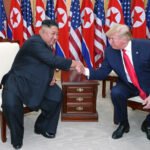TCL’s mini LED TVs on display at CES 2024 in Las Vegas
China’s TCL Technology, the world’s No. 2 TV maker, has been expanding its presence not only in the market for cheap LCD TVs but also for premium lines such as mini LED TVs, chipping away at the market share of the industry leader Samsung Electronics Co.
According to research firm Omdia, TCL accounted for 12.6% of global TV shipments in the first quarter of this year, up 0.7 percentage point from 11.9% in the year prior. That is in contrast to a decline in Samsung’s market share to 18.8% from 20.3% during the same period.
LG’s market share remained steady at 11.8% versus 11.7%. TCL overtook the South Korean brand in 2022.
Its ascent in the TV market is more notable in terms of sales value that grew at a faster pace than the rise in its sales volume. That indicated it sold more high-end products than the previous years.
In the quarter ending in March, it controlled 11.6% of TV sales in terms of value, up 1.8 percentage point compared with 9.8% in the year prior.
By contrast, Samsung and LG saw their share slipping in the same period.
Major TV makers’ market share in terms of value
Company
Q1, 2024
Q1, 2023
TCL
11.6%
9.8%
Samsung Electronics
29.3%
31.9%
LG Electronics
16.7%
17.0%
(Source: Omdia)
Behind its advance in the global market was mini LED TVs that it developed in 2019 for the first time in the world.
They use LED backlights that are around one-fortieth of the size of regular LEDs.
Samsung and LG have launched mini LED TVs with the product names of QLED and QNED TVs to catch up with the Chinese rival. But they are still trailing behind TCL in the LED TV market.
TCL’s flagship 98-inch mini LED TV sells at about half of those of South Korean brands of similar specification.
Samsung Electronics’ Neo QLED TV
TCL is sharpening its technology to further narrow its gap with Samsung. Early this year, it launched an 115-inch mini LED TV, the world’s largest of its kind. Next month, it will unveil a premium TV jointly developed by Bang & Olufsen, the world’s largest speaker maker.
TCL has invested more than 6 trillion won ($4.4 billion) in developing mini LED panels. Its subsidiary CSOT was selected as the preferred buyer of LG Display Co.’s liquid crystal display (LCD) panel plant in Guangzhou, China in a deal estimated at about 2 trillion won ($1.5 billion), according to LG Display’s regulatory filing last week.
If the deal goes through, the plant will supply TCL with LCD panels on a stable basis and could drive its TV prices further lower.
LG Electronics’ AI-enabled OLED evo TV
The growing mini LED TV market is offering a tailwind to TCL as well.
According to display industry tracker DSCC, the mini LED TV shipments are expected to surpass those of OLED TVs by around 2027.
To outsmart TCL, Samsung focuses on connect multiple home appliances such as TVs, air conditioners and refrigerators to provide customized, smart home services.
LG has introduced a web operating system (WebOS)-based TV platform available for smart TVs with a focus on its flagship OLED TVs. On the TV platform, a user connects to the internet and downloads on-demand content from apps, while accessing streaming services.
“If Samsung and LG fails to secure killer content, they will lose even the TV market, the last bastion of home appliances, to China,” said a South Korea TV company official.
By Chae-Yeon Kim
Why29@hankyung.com
Yeonhee Kim edited this article















